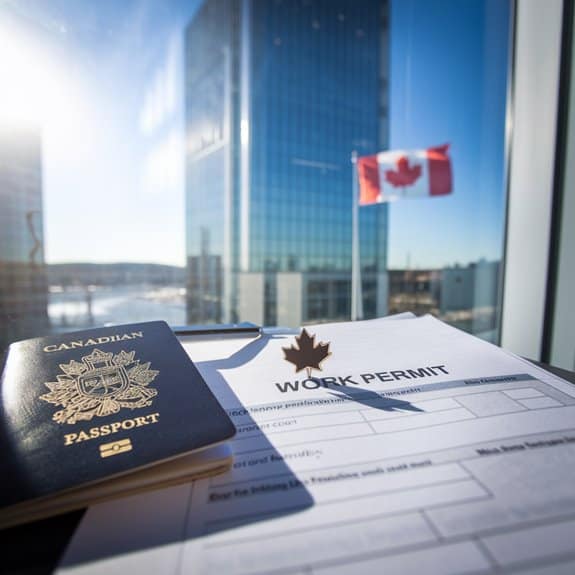
You’ll find major changes to Canada’s LMIA-exempt work permits in 2025, including new restrictions on spousal permits and expanded provincial nominee options. The Global Hypergrowth Project introduces permits for high-skilled workers, while intra-company transfer criteria become stricter. Updates affect TR to PR pathways through December 2026, and spouses of international students face limitations. These shifts reshape immigration pathways with more details emerging on specific programs and eligibility requirements.
Changes to Spousal Open Work Permits
Major changes to Canada’s Spousal Open Work Permit (SOWP) program took effect on March 19, 2024, considerably limiting eligibility for spouses of international students.
If your spouse is enrolled in most bachelor’s or college programs, you’re no longer eligible for a SOWP.
You’ll still qualify for a SOWP if your spouse is pursuing a master’s or doctoral degree.
There are also exceptions for specific vocational programs, including Doctor of Medicine, Bachelor of Engineering, and Bachelor of Science in Nursing.
Additional restrictions announced for September 2024 will further limit SOWP eligibility for spouses of students in master’s programs under 16 months and temporary workers in certain occupations, though these changes haven’t been implemented as of January 2025.
Global Hypergrowth Project Work Permits
A new LMIA-exempt work permit launched on April 15, 2024, as part of Canada’s Innovation Stream pilot program, offering high-skilled workers at select companies permits valid for up to five years.
The program targets professionals in NOC TEER 0 or 1 occupations and features expedited processing to help companies fill critical roles quickly.
Fast-tracked work permits are available to senior professionals and managers, enabling innovation companies to secure top talent efficiently.
If you’re considering this permit, you’ll need to meet these key requirements:
- Employment offer from a participating company (such as Ada Support Inc., AlayaCare, or CellCarta)
- Qualifications for high-skilled positions within NOC TEER 0 or 1 categories
- Ability to meet standard work permit criteria, including admissibility requirements
The Global Hypergrowth Project is scheduled to run until March 22, 2026, supporting Canada’s innovation sector through streamlined immigration pathways.
Provincial Nominee Program Open Work Permits
Since August 11, 2024, certain Provincial Nominee Program (PNP) candidates have gained access to open work permits while their nominations are being processed.
To qualify, you’ll need a support letter from your nominating province or territory and a letter from your current employer.
You must also meet one of three conditions related to your work permit status: either hold a valid work permit, have applied to extend your work permit before it expired, or have applied to restore your status within 90 days of your work permit expiring.
This initiative has been implemented by Alberta, Manitoba, and Yukon to help nominees maintain legal work authorization during the nomination process.
The program guarantees you can continue working legally in Canada while awaiting the outcome of your PNP application.
Intra-Company Transferee Updates
Under revised guidelines effective October 3, 2024, qualifying for an intra-company transferee (ICT) work permit in Canada has become more stringent.
You’ll need to guarantee your company meets the updated criteria for multinational corporation status and demonstrate specialized knowledge that’s essential for Canadian operations.
The key changes you should be aware of include:
Stay informed about essential updates to Canada’s ICT work permit requirements to ensure your application meets new standards.
- Your foreign employer must now provide detailed evidence of its legitimate multinational operations and business activities.
- You’ll need to clearly demonstrate specialized knowledge that’s unique to your company’s products, services, or processes.
- You can’t use the ICT stream for general workforce transfers, as permits are strictly limited to essential specialized roles.
These updates aim to maintain the program’s integrity while guaranteeing ICTs serve their intended purpose within Canadian businesses.
TR to PR Pathway Extensions
Through an extension announced on December 17, 2024, Canada’s Temporary Resident to Permanent Resident (TR to PR) pathway now offers continued work permit opportunities until December 31, 2026.
If you’re a TR to PR pathway applicant with a valid work permit that’s set to expire within four months, you’ll be eligible to apply for an open work permit to maintain your status in Canada.
Your family members may also qualify for open work permits under this extension, allowing them to work while your permanent residence application is being processed.
It’s essential to recognize that while this policy is currently scheduled to run until the end of 2026, the government retains the right to revoke or modify these provisions without prior notice.
Entry Requirements for Mexican Nationals
As of February 29, 2024, Mexican nationals must obtain a Temporary Resident Visa (TRV) before entering Canada, marking a significant change from their previous visa-exempt status.
This policy shift comes in response to an increase in asylum claims from Mexican citizens during 2023.
If you’re a Mexican national planning to visit Canada, you’ll need to be aware of these key requirements:
- You must apply for and receive a TRV before travelling to Canada.
- You can’t rely on the electronic Travel Authorization (eTA) system anymore.
- You’ll need to meet standard visitor visa requirements, including proof of funds, purpose of visit, and ties to your home country.
These new entry requirements apply to all Mexican nationals, regardless of their previous travel history to Canada or their intended length of stay.
New Restrictions on Flagpoling
The Canadian government has implemented a significant change to border processing by banning flagpoling effective December 23, 2024. You’ll no longer be able to exit and re-enter Canada on the same day to process your immigration documents at ports of entry. This change affects most temporary residents seeking to update their status.
| Group | Flagpoling Exception Status |
|---|---|
| U.S. Citizens | Still permitted |
| International Truck Drivers | Still permitted |
| NEXUS Card Holders | Case-by-case basis |
| Students | Not permitted |
| Temporary Workers | Not permitted |
The ban aims to reduce processing pressures at land borders and guarantee more consistent application processing. You’ll need to plan ahead and use online services or inland offices for your immigration needs, as same-day border services are no longer available for most temporary residents.
IMP Work Permit Targets and Quotas
Canada’s immigration system has introduced new targets for International Mobility Program (IMP) work permits spanning 2025-2027, marking a significant shift in temporary resident management.
The government’s goal is to reduce the overall temporary resident population from 7% to 5% of Canada’s total population through careful monitoring and control of work permit issuance.
You’ll need to be aware of these key changes:
- New annual quotas will limit the number of IMP work permits issued each year.
- Certain occupation categories will face stricter eligibility requirements.
- Your employer may need to demonstrate why they can’t fill positions locally before hiring through IMP.
These measures aim to balance Canada’s labour market needs while ensuring sustainable population growth through permanent immigration channels rather than temporary programs.
Key Occupational Categories and Eligibility
Specific occupational categories now play a defining role in determining work permit eligibility under Canada’s revised immigration policies.
You’ll find that high-skilled positions within NOC TEER 0 or 1 receive priority processing under the Global Hypergrowth Project, which offers permits valid for up to five years.
Notable exceptions exist for spouses of students in specific professional programs, including Doctor of Medicine, Bachelor of Engineering, and Doctor of Veterinary Medicine.
For intra-company transferees, there’s an enhanced focus on specialized knowledge positions, with stricter evaluation criteria for multinational corporations.
You’ll need to demonstrate that your role requires unique expertise that’s essential to the Canadian operation.
The new framework also emphasizes certain provincial nominee occupations, particularly in Alberta, Manitoba, and Yukon, where labour market demands are high.
How Canadian Currents Immigration Can Help
Steering complex immigration policies and frequent regulatory changes requires expert guidance, which is why our team at Canadian Currents Immigration provides extensive support through every step of your work permit application process.
Our experienced professionals, including immigration lawyers, consultants, and paralegals, work together to deliver tailored solutions for your specific immigration needs.
We’ll help you navigate the LMIA-exempt work permit process by:
- Evaluating your eligibility and identifying the most suitable work permit category
- Preparing and reviewing all required documentation to ascertain completeness and accuracy
- Providing ongoing support throughout the application process, including updates on regulatory changes and policy shifts
With decades of combined experience, we’re committed to securing the best possible outcome for your immigration journey while maintaining cost-effectiveness and efficiency.
Frequently Asked Questions
What Happens to Lmia-Exempt Work Permits if the Employer Goes Bankrupt?
If your employer goes bankrupt, your LMIA-exempt work permit becomes invalid. You’ll need to find a new employer and apply for a new work permit before continuing to work.
Can Lmia-Exempt Permit Holders Switch Employers Without Applying for a New Permit?
You can’t switch employers with an LMIA-exempt work permit. You’ll need to apply for a new permit specific to your new employer, even if the position is also LMIA-exempt.
How Long Is the Cooling-Off Period Between Consecutive Lmia-Exempt Work Permits?
You don’t face a mandatory cooling-off period between LMIA-exempt work permits. However, you’ll need to meet eligibility requirements and submit a new application for each permit.
Are Remote Workers Based Outside Canada Eligible for Lmia-Exempt Permits?
You aren’t eligible for LMIA-exempt work permits if you’re working remotely outside Canada. You must physically work within Canada’s borders to qualify for these permits.
What Medical Examinations Are Required for Lmia-Exempt Work Permit Renewals?
You’ll need a new medical exam if your previous one is over 12 months old and you work in healthcare, childcare, education, or agriculture, regardless of LMIA-exempt status.
Conclusion
You’ll need to carefully navigate Canada’s updated LMIA-exempt work permit landscape in 2024-2025. With new restrictions on spousal permits, the Global Hypergrowth Project launch, and modified ICT criteria, your eligibility requirements have changed considerably. Stay informed about provincial nomination opportunities and updated flagpoling rules. Contact an immigration professional to understand how these reforms affect your specific situation and explore the best pathway forward.

We serve ALL of Canada. Currently have offices Western Canada — Vancouver, Calgary, Edmonton, Kamloops and Red Deer. We also have the infrastructure to work with any of our clients virtually — even from the furthest regions of the Yukon to Newfoundland.
Call (778) 331-1164 [toll free 1 (844) 715-0940] to get routed to the best office for you or contact us online to schedule an appointment.
We also have a dedicated intake form to help you get the ball rolling. Our intake team will review your specific case and advise you on the next steps to take as well as what to expect moving forward.
Our offices are generally open 8:30 a.m.—4:30 p.m., Mon—Fri.

Alfonso Chen
IMMIGRATION LAWYER
Alfonso is a lawyer of our Vancouver office who provides services in both English and Mandarin. Prior to joining our firm, he worked at a full-service law firm for over four years, where he helped clients with a wide variety of family law matters, from drafting prenuptial agreements to negotiating terms for and drafting separation agreements to representing clients for divorces.



